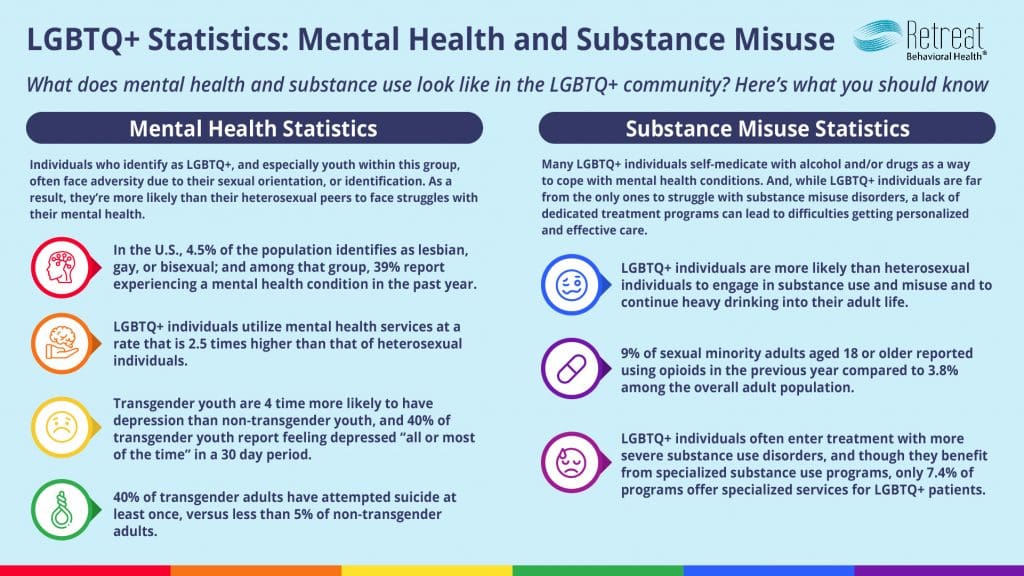Putting the Focus on LGBTQ+ Mental Health
June is Pride Month, and as we celebrate our LGBTQ+ communities it’s also a great time to shine a light on LGBTQ mental health and some of the struggles that those in the community face.
The month of June became ubiquitous with LGBTQ pride in the 1970s, following the liberation movement kickstarted by the Stonewall Riots in 1969. Today, the month is filled with inclusive celebrations and parades all over the world, as well as dedicated efforts to raise awareness about LGBTQ mental health and other important issues.
Although there has been an increase in LGBTQ+ rights, there are still many struggles the LGBTQ communities face such as discrimination, mental health, and substance misuse. We want to help provide not only invaluable awareness, but general support towards these issues—and in turn, make it easier for those in the community to reach out and get help if they need it.
LGBTQ Mental Health Statistics
LGBTQ individuals—and especially the youth in this community—are more likely than their heterosexual peers to face struggles with their mental health. This is largely due to adversity as a result of their sexual orientation and gender identification, and in many cases is further perpetuated by a lack of family support.
So what does LGBTQ mental health look like by the numbers? Here are some key statistics to be aware of:
- In the U.S., 4.5% of the population identifies as lesbian, gay, or bisexual; and among that group, 39% report experiencing a mental health condition in the past year.
- LGBTQ individuals utilize mental health services at a rate that is 2.5x higher than that of non-LGBTQ individuals.
- Transgender youths are 4x more likely to have depression than non-transgender youths, and 40% of transgender youth report feeling depressed “all or most of the time” in a 30 day period.
- 40% of transgender adults have attempted suicide at least once, versus less than 5% of non-transgender adults.
Statistics like these tell an important story about mental health in the LGBTQ community, including just how much higher the prevalence of mental health issues tends to be among sexual minorities. It also serves as a reminder to all of us that we have a role to play in ensuring people among the LGBTQ+ community feel safe, regardless of whether they’re a loved one or just a stranger who we pass by on the street.
LGBTQ Substance Misuse Statistics
Substance misuse is one of the more common mental health issues faced by LGTBQ individuals. It’s also one area where a lack of dedicated treatment programs hinders those in the community from getting the level of personalized support that they require in order to heal.
Some notable statistics concerning LGBTQ identifying people and substance misuse include:
- 9% of sexual minority adults aged 18 or older report using opioids in the previous year compared to 3.8% among the overall adult population.
- LGBTQ individuals are more likely than non-LGBTQ individuals to engage in substance misuse and to continue heavy drinking into their adult life.
- LGBTQ individuals often enter treatment with more severe substance misuse disorders, and though they benefit from specialized substance misuse programs, only 7.4% of programs offer specialized services for LGBT patients.
Recognizing higher rates of LGBTQ substance misuse is not enough. As part of offering qualified support, it is also clear that we need additional programs specialized around the LGBTQ experience and the needs of sexual minorities, which will help ensure that everyone gets the level of care they require.
Offering Solutions
The link between LGBTQ mental health and substance misuse is a strong one, with many people in the community looking to drugs and alcohol as a means to self-medicate and deal with adversity and the stigma of being a sexual minority.
At Retreat Behavioral Health, we’re dedicated to supporting the LGBTQ community with specialty services that address their unique mental health challenges. If you or a loved one is in need of mental health care, we encourage you to contact us to learn more about our mission and what programs we offer.





